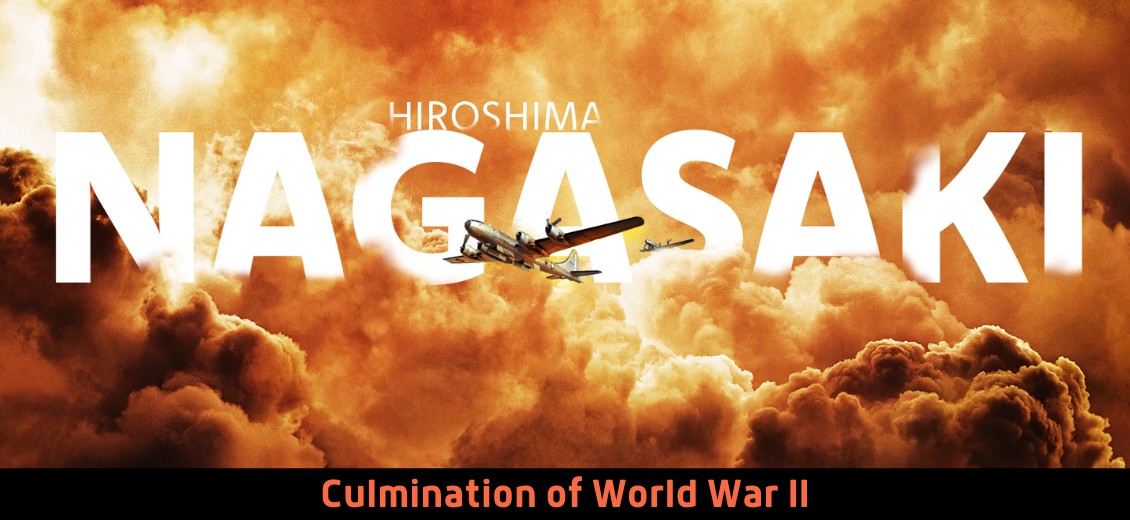Hiroshima & Nagasaki Bombings: Culmination of World War II
Blogs Home
- 09 Aug 2022

It is often repeated in history textbooks that the Second World War ended with America's attack on the Japanese cities of Hiroshima and Nagasaki. Seventy-seven years later, the incident remains a tragic reminder of the destruction caused by atomic bombs. In this era of weapons of mass destruction and the nuclear power race, we should not skip going back to the bombings of August 6 and August 9, 1945. One needs to ask and know the answers to the various important questions that cloud the facts - Why did America bomb the cities of Japan? What were the events that led to the bombings? How did Japan react to it? What were the aftermaths? How does it affect the cities of Hiroshima and Nagasaki and their citizens today? How did the bombings of 1945 shape Japan's relationship with the USA? What is the current relationship between the USA and Japan? Let’s try finding the answer to these questions…
Attack on Hiroshima And Nagasaki
On 6th August 1945, the world witnessed the destruction caused by the first atomic bomb named "Little Boy". It was dropped from the USAAF B29 bomber from a height of around 1800ft. It contained approximately 12.5-kilotonnes of TNT, turning the city of Hiroshima into a land of ashes and piles of dead bodies of those who remained, while many thousands vapourised.
Following the destruction in Hiroshima, Nagasaki was bombed at 11 in the morning on 9th August, by another bomb named "Fat Man". While the original target was another city, named Kokura, the bomb was dropped at Nagasaki due to a heavy cloud cover. The Fat man contained 6.4 kilograms of plutonium-239, equivalent to 22 kilo tonnes of TNT.
Events leading to the bombings and America's rationale
The US was dragged into the second World War and joined the allied forces after Japan attacked Pearl Harbour in 1941. The attack was a shocking event for the US and angered the citizens. With the death of President Roosevelt and the stepping of Harry Truman as the new face of the American Presidency, his key concern was to find a way to end the world war.
The only nuclear weapon that has ever been used in war was developed by the Manhattan Project which exploded on the two Japanese cities. They were developed under J. Robert Oppenheimer, a US physicist, and tested in the desert of New Mexico in July 1945. Upon this learning, the Truman administration issued the Potsdam Declaration. It demanded an unconditional surrender of the government of Japan, and warned of a " prompt and utter declaration".
According to a CNN report, Henry Stimson, Secretary of War was very adamant about the use of bomb. A professor of History at Harvard, Charles Maier stated that while it would have been possible for Truman to make another decision, it would have been hard to justify to the American public why he prolonged the war when the weapon was available.
Japan refused to surrender unconditionally and the Truman administration worried about a costly invasion of Japan. Since the Japanese were fighting for the emperor, they were convinced to die rather than surrender. This was witnessed in the use of suicidal Kamikaze attacks by the Japanese which was a rare event in the past. It created an impact on the US military and reinforced a belief that the Japanese would fight till the end.
The critics, however, argue that the bombings were not the only resort to end the war. President Eisenhower criticised the use of atomic bombs. While the bombings did convince the Emperor to intervene and support surrender, it doesn't imply that it was necessary. Critics argue that Japan may have ended the war if some of its conditions were kept in mind. Truman did not think of the atomic bomb attack as unnecessary. For him, "the sacrifice of Hiroshima and Nagasaki was urgent and necessary for the prospective welfare of both Japan and the Allies".
Japan's reaction to the bombings
At first, when Hiroshima was attacked, there was a late realisation that all communication was lost at Hiroshima. Many in the government had mistrusted that the USA could develop an atomic bomb. After Nagasaki was bombed, the disbelief in USA's ability faded away. Shigenori Togo, then foreign minister, called the ninth of August a "bad day" and recommended acceptance of the Potsdam Declaration that suggested Japan's surrender.
The Supreme War Direction Council of the War often referred to as the "Big Six" faced a deadlock on the decision to surrender. The Emperor, in an imperial conference held in Tokyo, demonstrated his desire for the war to end. On 14 August, after a cabinet meeting was called, the Emperor declared acceptance of the Potsdam conference, asking the members to accede to his order who were initially reluctant to the US demand that the emperor is placed under the Supreme Allied Commander's authority.
It should be mentioned that the Japanese military was not ready to surrender. They declined to be defeated and in the words of Vice Admiral of Kamikazes, Takijiro Onishi, the Japanese would never be defeated. It was only when the Emperor intervened that the Japanese finally surrendered. On August 15, 1945, the American military was informed of its surrender, leading to the end of the War.
After-effects of the Bombings
The immediate effects of the bombings are difficult to predict but one thing is certain, it was devastating in the numbers of casualties. While the number remains uncertain, if the Atomic Archives is to be believed, it is estimated that the number of lives lost in Hiroshima ranged between 70,000-80,000 and in Nagasaki over 35,000.
The radiation effects, however, increased the number of casualties. The number of deaths due to flash burns, blasts, and debris of buildings has no official records. According to the Hiroshima prefecture Health Department, deaths from burns were at 60%, debris at 30% and 10% from other injuries. The effect of radiation can be witnessed in the fact that 95% of survivors traced (in 3000ft.) suffered from some form of radiation disease. It is often believed that even those who did not die immediately, could survive for a few days or a maximum of 4 weeks, and eventually succumbed to radiation diseases.
The present situation of Hiroshima and Nagasaki
After the attack, almost 70% of buildings were destroyed by the blast. The Hiroshima Prefectural Industrial building remained, now seen as a symbol of destruction that occurred. Outlines of shadows of people who perished in the heat of atomic bombs are exhibited today in the Hiroshima Peace Memorial Museum, as constant reminders of what war and bombs can do to humanity. The daily life of Hiroshima is like any other Japanese city. Peace activists from across the city are advocates of disarmament. A plan was launched "Hiroshima 2045: City of Peace and Creativity" to design a modern urban landscape.
According to the Guardian report of 2017, Hiroshima has a population of 1.19 million today. However, the memories are difficult to suppress. The Hibakusha Community (Hibakusha is the Japanese word for people who were affected by the bombings of Hiroshima and Nagasaki) conserve a memory of the effects of the bombing. Today, while the cities have been rehabilitated, they have inherited the events of 1945 in their memories. The two cities are enthusiastic about the promotion of world peace and nuclear disarmament.
Japan's relationship with the US
It is often surprisingly noted that the Japan and US share a cordial relationship even after the attack on the two cities and the first ever use of atomic bombs by the USA. The two countries are allies today in the international environment. The Japanese Constitution of 1947 was influenced heavily by an American presence, and Article 9 declared that "Japanese people forever renounce war as a sovereign right of the nation and the threat or use of force as a means of settling international disputes".
Today, with the rising of threat China for both the USA and Japan, the two countries find it strategically important to align themselves against a common regional aggressor that aspires to establish a new hegemony. Japan and the USA have walked miles in their bilateral relations together. With an ever-changing and unpredictable 21st century, the nations find it only sensible to build strong relationships and strengthen them. Diplomatic relations, undoubtedly, will continue to improve, subject to the leadership of the respective nations. The moral question of the atomic attacks will remain a matter of debate and discussion, probably finding no real explanation.

Annie Pruthi
Annie is pursuing her masters in Political Science from JMI, Delhi, after graduating (Arts) from Gargi College, DU. She is an award-winning author. Her debut book "Will You Stay?" won "Most Promising Book, 2020 (Fiction)" title in the Coimbatore Literary Awards.
Blogs Home



